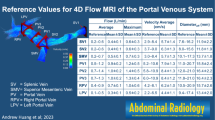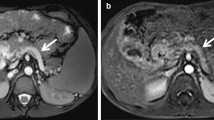Abstract
Purpose: To evaluate the MRI findings of retroperitoneal low-flow vascular malformations (RLVMs) correlated with histopathological findings. Methods: Two radiologists reviewed the MRI findings of 4 RLVMs (3 with capillary malformations and 1 with a venous malformation). First, they evaluated the visibility, signal intensities, and signal homogeneity of each lesion on non-fat-suppressed breath-hold T2-weighted single-shot fast spin-echo (non-FS SSFSE) images and fat-suppressed T2-weighted fast spin-echo (FS T2-weighted FSE) images. Second, the kinetic patterns and the internal enhancement patterns were analyzed for each lesion on multi-phasic contrast-enhanced (CE) images. After these image analyses, the MRI findings were correlated with the histopathological findings. Result: Histopathologically, the 4 RLVMs did not exhibit remarkable degeneration and were present in the retroperitoneal fat tissue without clear capsules. On the non-FS SSFSE images, 3 of the 4 RLVMs could not be discriminated from the surrounding retroperitoneal fat tissue (invisible), and the remaining lesion was barely visible with an indistinct margin. On the FS T2-weighted FSE images, however, all the RLVMs were clearly visualized as homogeneous high-signal intensities. On the multi-phasic CE images, all the capillary malformations exhibited fast enhancement, while a venous malformation showed slow enhancement. Furthermore, the RLVMs tended to exhibit a centripetal filling pattern. Conclusion: The RLVMs blended in with the surrounding retroperitoneal fat tissue on non-FS SSFSE images, like phantoms, whereas they were clearly visualized on FS T2-weighted FSE images. On multi-phasic CE images, the RLVMs tended to exhibit a centripetal filling pattern. These imaging features may be useful diagnostic clues for RLVMs.




Similar content being viewed by others
References
Mulliken JB, Glowacki J (1982) Hemangiomas and vascular malformations in infants and children: a classification based on endothelial characteristics. Plast Reconstr Surg 69:412–422
Jackson IT, Carreño R, Potparic Z, et al. (1993) Hemangiomas, vascular malformations, and lymphovenous malformations: classification and methods of treatment. Plast Reconstr Surg 91:1216–1230
Enjolras O (1997) Classification and management of the various superficial vascular anomalies: hemangiomas and vascular malformations. J Dermatol 24:701–710
Flors L, Leiva-Salinas C, Maqed IM, et al. (2011) MR imaging of soft-tissue vascular malformations: diagnosis, classification, and therapy follow-up. Radiographics 31:1321–1340
Moukaddam H, Pollak J, Haims AH (2009) MRI characteristics and classification of peripheral vascular malformations and tumors. Skeletal Radiol 38:535–547
Lowe LH, Marchant TC, Rivard DC, Scherbel AJ (2012) Vascular malformations: classification and terminology the radiologist needs to know. Semin Roentgenol 47:106–117
Donnelly LF, Adams DM, Bisset GS 3rd (2000) Vascular malformations and hemangiomas: a practical approach in a multidisciplinary clinic. AJR Am J Roentgenol 174:597–608
van Rijswijk CS, van der Linden E, van der Woude HJ, et al. (2002) Value of dynamic contrast-enhanced MR imaging in diagnosing and classifying peripheral vascular malformations. AJR Am J Roentgenol 178:1181–1187
Goodwin RW, O’Donnell P, Saifuddin A (2007) MRI appearances of common benign soft-tissue tumours. Clin Radiol 62:843–853
Hassanein AH, Mulliken JB, Fishman SJ, Greene AK (2011) Evaluation of terminology for vascular anomalies in current literature. Plast Reconstr Surg 127:347–351
Vilanova JC, Barceló J, Smirniotopoulos JG, et al. (2004) Hemangioma from head to toe: MR imaging with pathologic correlation. Radiographics 24:367–385
Meyer JS, Hoffer FA, Barnes PD, Mulloken JB (1991) Biological classification of soft-tissue vascular anomalies: MR correlation. AJR Am J Roentgenol 157:559–564
Hyodoh H, Hori M, Akiba H, et al. (2005) Peripheral vascular malformations: imaging, treatment approaches, and therapeutic issues. Radiographics 25(Suppl 1):S159–S171
Morris EA, Comstock CE, Lee CH, et al. (2013) ACR BI-RADS® magnetic resonance imaging. In: ACR BI-RADS® Atlas, breast imaging reporting and data system. Reston: American College of Radiology
Igarashi J, Hanazaki K (1998) Retroperitoneal venous hemangioma. Am J Gastroenterol 93:2292–2293
Rha SE, Byun JY, Jung SE, et al. (2003) Neurogenic tumors in the abdomen: tumor types and imaging characteristics. Radiographics 23:29–43
Nishino M, Hayakawa K, Minami M, et al. (2003) Primary retroperitoneal neoplasms: CT and MR imaging findings with anatomic and pathologic diagnostic clues. Radiographics 23:45–57
Blake MA, Kalra MK, Maher MM, et al. (2004) Pheochromocytoma: an imaging chameleon. Radiographics 24:S87–S99
Elsayes KM, Narra VR, Leyendecker JR, et al. (2005) MRI of adrenal and extraadrenal pheochromocytoma. AJR Am J Roentgenol 184:860–867
Lane RH, Stephens DH, Reiman HM (1989) Primary retroperitoneal neoplasms: CT findings in 90 cases with clinical and pathologic correlation. AJR Am J Roentgenol 152:83–89
Elsayes KM, Staveteig PT, Narra VR, et al. (2007) Retroperitoneal masses: magnetic resonance imaging findings with pathologic correlation. Curr Probl Diagn Radiol 36:97–106
Conflict of interest
All authors have no conflict of interest or commercial involvement.
Author information
Authors and Affiliations
Corresponding author
Rights and permissions
About this article
Cite this article
Akita, H., Yamada, Y., Ito, Y. et al. Retroperitoneal low-flow vascular malformations: characteristic MRI findings correlated with histopathological findings. Abdom Imaging 40, 1713–1720 (2015). https://doi.org/10.1007/s00261-014-0319-2
Published:
Issue Date:
DOI: https://doi.org/10.1007/s00261-014-0319-2




